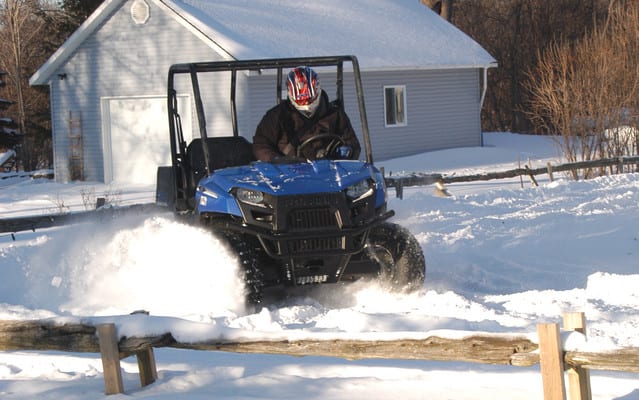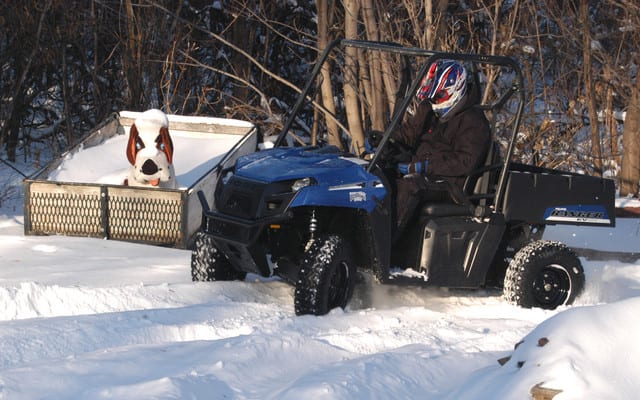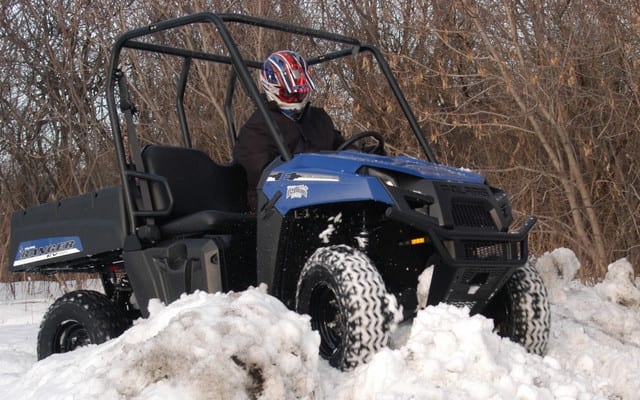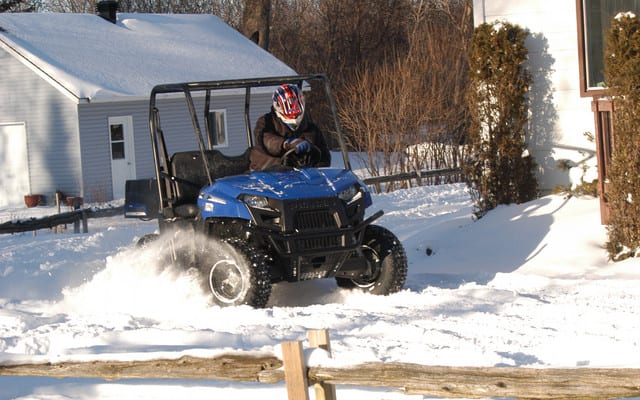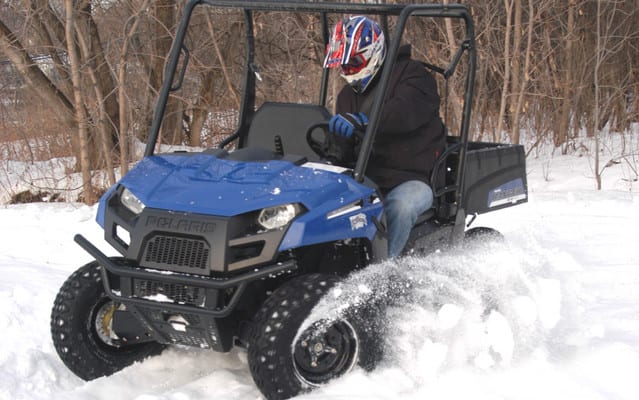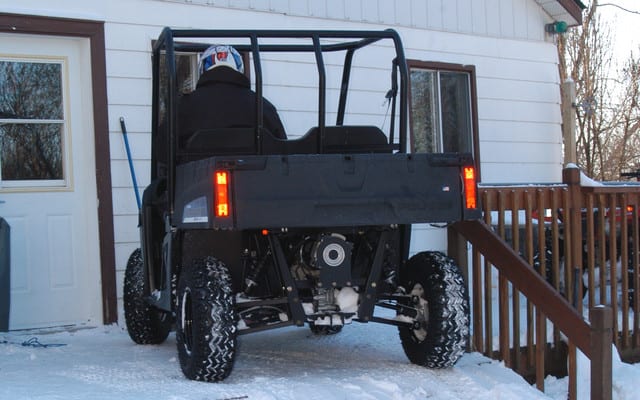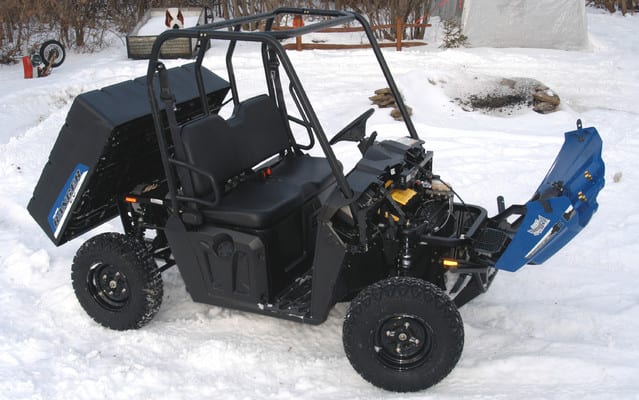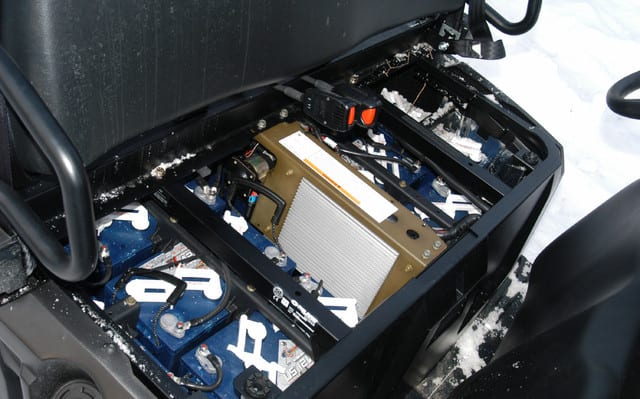The 2010 Polaris Ranger EV fit perfectly fine in the back of our ATV Trail Rider F-150 pickup truck, when I picked it up at Blain’s in Ste-Julie, Québec. The back tires on the pick-up got scared and went hiding deep inside the fenders. Fact is, it weighs almost twice as much as the Ranger 400, the other all-new Mid-size added to the already extensive line of diversified Polaris Ranger vehicles for 2010. The timing was just perfect, bad winter weather, crispy cold, but my coffee was nice and hot and that blue vehicle snug in the box wasn’t too shabby either. It seems we press people just love to give all these rides a hard time, and if there was any way of clarifying certain myths about electric vehicles, and giving this one a good challenge, it was by testing it in Québec’s worst of winter.
The lack of hesitation from Polaris in lending us one at that time of year, was actually quite encouraging. At first glance, sitting there in the truck bed, the tires similarity to those on the truck still hiding in the fenders had me doubting in the vehicles abilities to operate in deep snow. Of course I was also very well aware that this vehicle wasn’t really recommended for this sort of application; me just fooling around in the snow that is. For now, I was getting great extra traction to efficiently accelerate from a standstill at each traffic light. I wasn’t sure if carrying all this weight was really affecting the range of my pick-up all that much, as more weight also meant less useless wheel spin and playing around with the throttle to try and get the tires to grip. The drive back was at the very least very different, encouraging a more relaxed position with the seat back tilted down a few clicks, window half down, heater revving to the max.
I was totally aware of the fact that forward momentum would be a little more challenging to counter, with my front tires barely touching the ground. I aim to turn into a gas station and my Ford refuses to obey, go figure? It normally never misses an opportunity to have me pay for its unquenchable thirst. Ok, pump it, the brake pedal that is! All of a sudden my back is straight up and a cold breeze glides across it, as my cussing seemed to actually help in convincing the truck to finally turn. No big crash was avoided, but boy was I glad I wasn’t forced to ask any of the many available on-lookers, for a push out of that snow bank I had just re-shaped a little. Oh………that’s why it finally turned !!
Getting it out of the truck shouldn’t be too much of a problem; mind you I was worried my ramps would also show their disapproval of this 771 kg of beautifully engineered earth friendly vehicle, pressing down on them so hard. Can anyone blame them? Not many would accept so much added pressure at work. The un-loading procedure would have been perfect if the retaining chains on the ramps would have been more tightly bound to the tailgate. Now I had the tailgate looking all disgusted and crooked.
Going out and about
The all-new 2010 Polaris Ranger EV electric Side-by-Side is a first for Polaris. Sharing the same chassis as the Midsize RANGER 400, it offers all the same good things Rangers are known for ; On-Demand True All-Wheel Drive with VersaTrac, Independent Rear Suspension, heavy duty front end protection, high ground clearance and the longest suspension travel in their class. Designed for clean and quiet operation, the unit features the largest battery pack in the industry (11.5 kilowatts) and has the longest range of any electric Midsize UTV. I already had a taste for its driving aspects in the middle of summer at the Polaris R&D facility in Wyoming, Minnesota, which greatly resembled those of its gas powered counterpart; the Ranger 400. That one actually only offered a tad more speed. This time around the EV was on my turf, or rather snow covered turf.
If it could just hold its own for an hour of abuse riding in High mode, in a foot of snow or more, always in 4wd, I would consider it to be more than acceptable, since this one is much more intended for practical usage, without any of this sort of useless fooling around. Of course I just couldn’t help myself and drove off in the EV as soon as I was done taking notice of the damage done to my tailgate. By then the sun was gone and it got even colder, around -30 degrees. The power gauge showed half a tank, eh, I mean half a charge. I’m guessing that the fact that the vehicle had just been blasted with cold air for the 50 minute drive back didn’t help the batteries. Lights blazing and bum frozen, I selected High and 4WD and never lifted the foot off the pedal until the automatic switch down into Max range mode, was obviously felt 30 minutes later. One very good thing I noticed during this short but intense cold winter evening test, was that the gauge had quickly dropped and then the vehicle kept going for about 20 minutes with the first two led lights on the gauge flashing in alert. Also nice is the fact that the vehicle then gradually lost power to move about and didn’t just drop dead after running normally, like an engine running out of gas would do without pity. This gave me a chance to feel the complete drain coming gradually, and for that reason I was able to park the vehicle back inside in its well ventilated garage as is recommended, on its own power, but very slowly.
The unit features three modes: High for speed, Low for towing and hauling, and Max for maximum range. The Max range worked perfectly fine in the cold and snow too and one can only activate the High mode only when needed, to get through a little more snow on occasion. Of course this may not be the best choice for someone who really wants to ride far out into the wilderness but it can certainly be very appealing to people who enjoy the occasional short ride out and about, in a soothingly quiet fashion.
Shifting the 2010 Polaris Ranger EV into forward, neutral or reverse gears is done by the simple press of vertically operated toggle switch button, placed on the center console. At first glance, it seemed nice, but I quickly got to hate using it in tight situations, where fast switching from forward to reverse a couple of times in sequence, was needed. Also, the switch sometimes doesn’t respond if it is flipped too quickly from Forward down to the Reverse position, without stopping on the Neutral position in between for a fraction of a second. When this happened a small red indicator light with a little wrench on it came on and the vehicle only responded again once the switch was clicked back to the neutral position. I guess it takes some getting used to.
For now, after three times out with my newfound friend, it seems I still need to locate it at every gear change, a task even more annoying at night. That button is actually the only one without any lights in it, while the power management mode switch and drive mode selector are illuminated. I just think this vehicle’s drivability in a work environment would be much improved if the shifting was done through the usual hand operated gear selection lever found in other Rangers. This also brings me to thinking that the time it takes to change the levers position, might suffice in giving the transmission this short time it seems to need to switch from forward to reverse, or vice-versa.
Bring it on
Surprisingly, this new electricity powered Ranger has the same load and towing capacity as its fuel burning brother. A set of eight 12-volt US12VXC batteries setup in a series-parallel configuration create an 11.7kW power delivery battery pack at 48V DC to power the Single 48 Volt, High Efficiency, AC Induction motor, which in turn is controlled by a 650 – Amp Sevcon Gen IV controller with multi-mode driving. Regenerative braking is another key feature making the vehicle last longer on a charge and also good smooth feel in descent control. It takes eight hours to charge the vehicle back up from a complete drain, which will then able the fun vehicle a range of 80 kilometers if you are riding on flat grounds in ‘Max Range’ driving mode. In the cold conditions we were driving it now, that figure drops about 20%. If you keep it in High mode and gunned to the floor, which will bring you up to a top speed of 40 km/h in a surprisingly quick fashion, it might only last a few hours, but imagine what this means if one is only in need of a work horse, used frequently for short periods of time in and around his property, how easier and cheaper it will be to keep it constantly ready for action, through any common household outlet.
Believe me when I say that it can actually be much more efficient both in strength for pushing or pulling and in worry free maintenance, to make the perfect work tool in countless applications. In this type of usage, there is no stopping this thing! And now we know that to be true even in the worst conditions possible for an electric vehicle, our Canadian winters. I even recommend snapping on a snow plow to the front of this one which will do an even better job at pushing snow than any other gas powered Ranger.
I have to admit being very impressed with the 2010 Polaris Ranger EV’s conquering abilities and general behavior in a winter setting. My doubts on the ability of the Carlisle tires were transformed into a great appreciation for how efficient they were in snow. They seemed thoroughly happy with all of this weight pressing down on them to grip better. We didn’t have a Ranger 400 to compare, but I am certain that we wouldn’t have been climbing so easily up those snow packed stairs and onto my friend Christian’s deck with that one (don’t worry I loves that sort of thing, he’s the one who told me to try it).
No need to take a swing, that climb was done slow and even jerking as I would tease the pedal and get a feel for things. That EV felt like a spider sticking to a wall, the task was a joke for it. Another very advantageous thing was felt about the direct drive transmission, whichever mode I was in; the first second of the power delivery, was gradual enough to avoid wheel spin. This trait was perfect on snow as the first rotation of the tires is always very efficient in getting the vehicle in motion instantly upon demand. I was sure I would succeed in getting it stuck in a 4 foot high snow bank, but ended up plowing through it repeatedly until totally destroying it instead. At faster speed on flat packed snow, I did feel some under steer from all that weight trying to push forward, but nothing too troublesome.
Accepting difference
Sadly, throughout my testing period with this great vehicle, I realized how people had a tendency to take a very skeptical position from the get go, some not even giving it a chance. It seems many advantages brought on by this type of motorization are not taken in consideration, things like the fact that it needs almost no maintenance and should run much more efficiently since there is almost nothing that can mechanically go wrong. Forget about all those liquids, filters, fuel adjustments, cooling efficiency or a million other things, mind you there is the transmission oil level to be checked periodically. The 2010 Polaris Ranger EV does away with all of that fuss and only batteries are expected to need replacement after about four years. It seems that as with anything else, the mere fact of something being different can scare some away. Most need convincing on lots of aspects they have preconceived ideas on, before they even bother to try it. All are pleasantly surprised, after they do drive it. I know I was simply amazed! It seems I still have a little more work to do to convince more people that electric vehicles can satisfy all their needs.
For more information on the above mentioned models, please visit the Polaris Website
More from Polaris on ATV Trail Rider :
Polaris ATV Models – Polaris UTV Models – Polaris ATV Reviews – Polaris UTV Reviews


